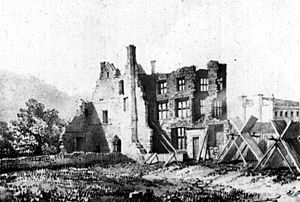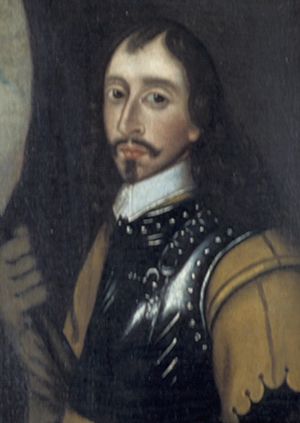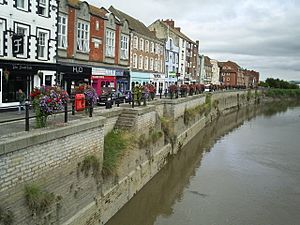Siege of Bridgwater (1645) facts for kids
Quick facts for kids Siege of Bridgwater (1645) |
|||||||
|---|---|---|---|---|---|---|---|
| Part of Wars of the Three Kingdoms | |||||||
 Bridgwater Castle ruins, around 1746 |
|||||||
|
|||||||
| Belligerents | |||||||
| Commanders and leaders | |||||||
| Strength | |||||||
| 1,800 | 15,000 (maximum) | ||||||
| Casualties and losses | |||||||
| minimal; 1,600 prisoners | 20 dead, 100 wounded | ||||||
The Siege of Bridgwater was a big battle in July 1645 during the First English Civil War. It happened when a Royalist army in Bridgwater gave up to a Parliamentarian army led by Sir Thomas Fairfax.
After winning the Battle of Naseby in June, Sir Thomas Fairfax and his New Model Army went to Somerset. There, they joined forces with the Western Association Army, led by Edward Massey. On July 10, their combined armies defeated the last major Royalist army at the Battle of Langport. This victory opened the way for them to attack Bridgwater.
The siege of Bridgwater started on July 13. On July 21, the Parliamentarian soldiers attacked the western part of the town. Many buildings caught fire. The Royalist army gave up on July 23. Over 1,600 prisoners were taken, along with many weapons and supplies.
Taking Bridgwater meant Parliamentarian forces now controlled a line of forts. These forts stretched from the Bristol Channel to the English Channel. This cut off the Royalist-held West Country from the rest of England. Fairfax then captured Bath and Sherborne, Dorset in August. In early September, he moved to attack Bristol, which was the most important port still held by the Royalists.
Contents
Why the Siege Happened
At the start of 1645, the Royalists still controlled much of the West Country. They also held parts of Wales and counties near the English border. On June 14, the New Model Army led by Sir Thomas Fairfax won a huge victory. They defeated Prince Rupert at the Battle of Naseby. This meant that Lord Goring's Western Army was the last big Royalist fighting force left.
The New Model Army joined up with the Western Association Army. This army was led by Edward Massey. Together, they forced Goring to stop blocking Taunton. The very next day, Fairfax completely destroyed the Royalist Western Army at the Battle of Langport.
Before attacking the Royalist port of Bristol, Fairfax needed to make sure his army was safe from behind. Many parts of the West Country were controlled by Clubmen. These were local groups of people who formed militias. They wanted to stop damage from either side in the war. Sometimes, they were even more of a threat than the Royalists.
Many Royalist soldiers who ran away from Langport were killed by the Somerset Clubmen. This was because the Royalists had caused a lot of damage when they were in the area. The main goal for these Clubmen was to end the war. Fairfax convinced their leaders that not helping the Royalists was the fastest way to do this. The Clubmen agreed to stay neutral. In return, Parliament promised to pay for any supplies they took.
This agreement allowed Fairfax to let his soldiers rest and gather supplies. He then arrived at Bridgwater on July 13. Before starting the siege, the New Model Army captured Sydenham Manor. This manor was just east of the town. Massey cleared out Royalist outposts at Hamp. This gave him control of the high ground to the south. Also, ships blocked the sea, stopping the Royalists in Bridgwater from getting supplies.
The Siege Begins

Bridgwater was built on both sides of the River Parrett. This river flowed into the sea at Bridgwater Bay, about 10 miles away. This made Bridgwater a very important place for trade. Even though many people in the town supported Parliament, the Royalists had held it since June 1643. Its governor was Sir Edmund Wyndham, who used to be the local Member of Parliament.
After the Battle of Langport, Goring's army went through Bridgwater and into Devon. He left most of his cannons there. He also left a group of about 1,800 soldiers. They had plenty of food and ammunition.
The town was surrounded by a deep moat, about 5.5 meters wide. This moat was connected to the sea, so it filled up with water at every high tide. The main defenses were on the western side of the River Parrett. This included Bridgwater Castle. The castle had been left empty in the mid-1500s. Its outer walls were still very strong, but they were not built to stop modern cannons. The defenders also built earth walls on the east side. These walls had 40 guns. There was another group of guns between the west and north gates.
On July 14, the Parliamentarians tried a surprise attack from the north side at night. But they stopped the attack. The soldiers found that the water in the moat was too deep. Their ladders could not reach the walls. The next few days were spent building siege works. These were trenches and walls meant to block off the town. However, the commanders decided this was taking too long. So, they planned another attack.
The Attack and Surrender
1,200 soldiers were chosen for the attack. They were divided into a main group of 600, and two smaller groups of 400 and 200. At 2:00 AM on Monday, July 21, Massey's cannons started firing from the south. The attacking groups crossed the River Parrett using three pontoon bridges. Even though the castle fired heavily, many shots missed. Not many soldiers were hurt, with 20 dead and 100 wounded.
The east gate was quickly captured and opened. This allowed the main Parliamentarian army to enter the town. By midday, they had taken 600 prisoners. The Royalists now only held the western half of the town.
Much of the eastern part of the town caught fire. People disagree about who started the fires. The Royalist soldiers in the town were offered a chance to surrender, but they refused. A second attack was planned for Tuesday, July 22. By this time, it was clear the defenders had no hope. Fairfax allowed over 800 people who were not soldiers to leave the town. Then, the Parliamentarians started firing into the Royalist-held area. This part of the town soon caught fire too.
Finally, the two sides agreed on terms. The Royalist army officially gave up on Wednesday, July 23.
What Happened Next
In those days, if an army surrendered before their walls were broken, they were usually allowed to leave with their belongings. They would also get a safe pass to the nearest friendly place. But this did not happen at Bridgwater. Most of the 1,500 regular soldiers changed sides. More than 200 officers and many Royalist officials were taken prisoner.
Fairfax also captured 40 cannons, gunpowder, and a "great store of muskets." These were left behind by Goring. Most of Goring's foot soldiers had run away after Langport. They were very discouraged by their defeat. Even if Goring could find new soldiers, he could not arm them without these weapons.
Sir Edmund Wyndham was held prisoner until 1649. He then joined Charles II in exile. He only returned after the king was put back on the throne in 1660. His son, Hugh, was also taken prisoner but escaped. He then joined the Royalist fleet led by Prince Rupert. He was captured again in 1649 while trying to escape from Kinsale. But he survived and later became a Member of Parliament for Minehead in 1661.
Bridgwater was badly damaged by the siege. It took many years for the town to recover economically. In December 1647, Fairfax wrote a letter to Parliament. He asked for taxes on the town to be lowered. This was "owing to its great losses in the recent siege."
Images for kids
-
Edward Massey, commander of the Western Association





